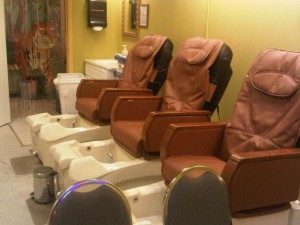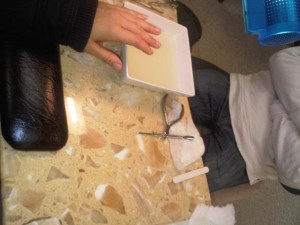Salon Sanitation
Author: Teddie Livingston | Filed under: Localizing story, Spring 2012, Student ContributorNail salon sanitation has become a rising problem in northwest Ohio, according to Ohio State Board of Cosmetology officials.
Clients are concerned about communicable bacteria and diseases, according to salon inspector Meg LaMantia.
The Ohio State Board of Cosmetology fines salon owners for violating operation and sanitation standards.
All equipment, employees and items in a licensed facility are mandated to maintain sanitation standards set by the board.
In order to receive a license from the Ohio State Board of Cosmetology, nail technicians must successfully complete 200 hours of formal training in a licensed school of cosmetology.
LaMantia is a hair, nail and tanning salon inspector in 12 counties, including Wood County. “Inspectors used to visit salons every six months, but because of a slim budget, we visit approximately every 10 months to once a year,” LaMantia said.
In 2010, about 250 violations issued by LaMantia, she said. In 2011, she issued about 300 violations. In 2012, she has issued 20 violations already. In past years, she only issued only a dozen violations to Bowling Green salons, which include tanning salons.
“Not having a current, updated license is the primary issue, then sanitation,” she said.
Recent salon inspection issued warnings and fines to local salons such as Salon Uptown, Teri Lynn’s Salon and Fiesta Hair and Tanning in Maumee, and Foster’s Hair Concepts Unlimited in Toledo, according to WTOL state inspection reports. Salons were cited for violations such as invalid salon license, unsanitary equipment and contaminated sanitary rooms.
Fines vary ranging $500 and up, LaMantia explained. However, salons have another option: a settlement agreement. The salon pays half the fine and is placed on prohibition for a year. If any violations occur while the salon is on prohibition, the license will be revoked.
The state board job is to ensure public safety, said Jim Trakas, executive director of Ohio State Board of Cosmetology. “We make sure well-trained, qualified professionals are serving the public,”Trakas said.
“We’re not trying to get money; we’re trying to discourage salon behavior that is outside the law,” Trakas said.
Kenny Ngyen, a nail technician at World Nail, which is located inside Woodland Mall, said his company tries to avoid violating state rules. World Nails workers are reminded to clean in the morning, in between clients and at end of the day cleaning.
Customers are provided with new files, multitasking nail buffers and properly sanitized equipment. After each client, every piece of used equipment is placed into a sterilization pouch, which is the proper way to sanitize equipment, according to Ngyen. Then the pouch is placed into a UV sterilizer that can kill bacteria within one minute, he said.
Clients at World Nail are provided with “pipeless pedicure chairs,” Ngyen said. “The chairs are highly recommended by state board,” he said. The jets in the pedicure bowl push out all the used water from the last client. Then the pedicure bowls are cleaned with a hospice-grade disinfectant.
If Ngyen notices anything that looks contagious on a client, he always asks if it may be contagious or if the infected area has been checked out by a doctor. “Many nail techs should not be scared to ask or request clients to get an infected area checked by a doctor,” Ngyen said.
Manicures and pedicures are the most common way to get an infection, according to Ngyen. “I try not to use cuticle tools because it can be damaging to the nail bed, which can damage the cuticleand create an infection,” he said. If proper s anitation policies are not followed bacteria, can build up and cause fungus to form on the nail.
Ngyen suggest clients to watch out for two things when it comes to acrylic nails. The first one is the quality of the powder used by the nail technician. “If the powder is not good quality, over time it will eat down your nail,” he said. The second concern is when the nails are wet, the acrylic starts to rise, which allows moisture to enter underneath the acrylic. The moisture can cause fungus or mold to form onto the real nail.
World Nail customer Ashley Galligan said she goes to World Nail because the workers value their reputation and treat their clients with care. Galligan said she does not worry about sanitation at the salon; she believes everything has been properly santized.
As salons continue to multiply, Galligan understands salon inspectors have more area that cannot be covered all at once. She tries to always remember to ask. “Have the tools been cleaned?” Galligan said.
For every salon inspector there are 18,000 salons, LaMantia said.
Purchasing a personal nail kit is a very safe, inexpensive alternate method clients can do instead of using salon equipment.
Here are some other tips from Trakas and LaMantia:
Make sure the salon is licensed.
Make sure the implements have been cleaned.
Make sure the salon and stations are clean.
Make sure the technician is clean and has clean hands.
If you see something wrong, say something.
To report license or sanitary issues, customers can fill out a complaint form or call (614) 466-3834.
Tags: Ohio State Board of Cosmetology, sanitation, World Nail

